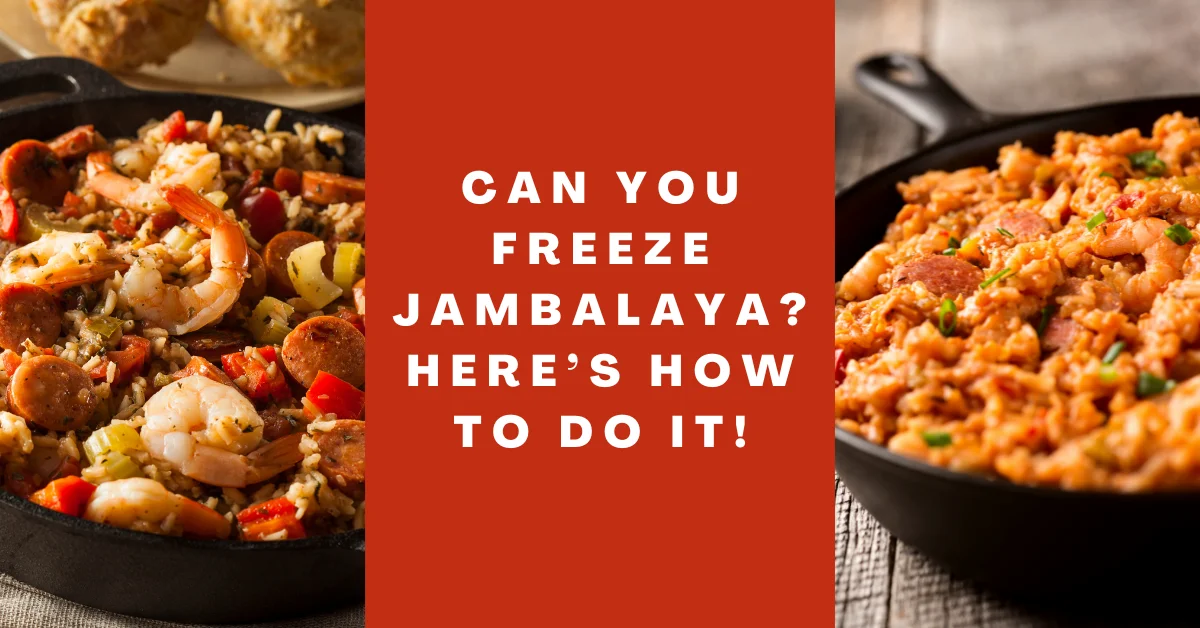One of our favorite rice dishes, probably the most favorite, is Jambalaya. The exotic blend of chicken, andouille sausage, seafood, and vegetables makes the dish irresistible. It is an easy yet flavourful dish that would brighten even the dullest of days. Jambalaya is also just the right comfort food to satisfy your midnight cravings.
But you know what would be even better? If you could freeze the rice dish and enjoy it later without having to cook it from scratch! But can you freeze Jambalaya? Keep reading to find out!
Yes, you can freeze Jambalaya. You will have to be careful and use an airtight container so that the rice doesn’t get mushy. However, it is possible that the dish won’t taste as good as when freshly prepared.
How do you freeze jambalaya?
Freezing jambalaya is a very attractive option especially when you’re in the mood to just get some quick yet tasty dinner on a Sunday night. The following are some ways to freeze it which have been discussed step-wise for your ease.
METHOD 1: Vacuum sealing
STEP 1: Prepare the bag
Prepare your vacuum sealing bag.
STEP 2: Fill it in
Fill the bag with the rice that you want to freeze.
STEP 3: Leave some space
Leave at least three to five inches of space empty in the bag after you’ve filled in the rice.
STEP 4: Take the air out
Use the vacuum to pull out all the air so that the bag is completely air-free.
STEP 5: Freeze it up
Put the bag in the freezer and freeze it to enjoy later!
METHOD 2: Double bagging
STEP 1: Put the Jambalaya in a ziplock bag
Get a ziplock bag and place your rice inside it. Make sure to leave 2-3 inches of empty space after putting the rice in the bag.
STEP 2: Take out as much air as possible
Roll the bag to push out as much air as you can from the bag. Air will affect the texture of your food that’s why it is better to have as little of it as you can.
STEP 3: Seal the bag
Carefully seal the bag while making sure that no air gets inside it.
STEP 4: Double pack the bag
Place the sealed bag in another ziplock bag to ensure insulation and prevent freezer burn. Alternatively, you can also wrap the sealed bag in aluminum foil. The aluminum technique might work better than the double ziplock bag technique.
STEP 5: Freeze it up
Place the double ziplock bag or aluminum foil-wrapped bag in the freezer and enjoy it later!
How to defrost jambalaya?
Defrosting jambalaya is an important step as not carrying it out properly can result in bacterial growth and even adverse health effects. Therefore, we have discussed it here in detail for your ease!
STEP 1: Place frozen jambalaya in your refrigerator
Take the jambalaya out of the freezer and place it in the fridge for thawing. This will ensure that it thaws evenly without bacterial growth.
STEP 2: Reheat it
After some hours have passed, take the jambalaya out and reheat it in a microwave, oven, or stovetop. The proper steps are provided below.
What is the best way to reheat jambalaya?
There are a bunch of choices when it comes to reheating your jambalaya. Below, we have discussed the different options in steps.
Note: One important point to remember is that if there are shrimps in your jambalaya, then they will most definitely become chewy upon reheating and you won’t be able to eat the dish.
METHOD 1: Reheating in a microwave
Microwaves are present in every home and result in quickly heated dishes. Follow the steps below to reheat your jambalaya ASAP!
STEP 1: Defrost it
Take the frozen jambalaya out of the freezer and put it in the refrigerator for defrosting.
STEP 2: Transfer the dish to a microwave-safe container
After the jambalaya has been defrosted, transfer it into a microwave-safe container. If it was already frozen in such a container then you can skip this step.
STEP 3: Microwave it
Microwave the dish with 30-second intervals to stir in between for even heating.
STEP 4: Enjoy it!
Savor your jambalaya after letting it cool for 30 seconds.
METHOD 2: Reheat on the stovetop
You can reheat jambalaya over the stovetop just like other yummy dishes such as queso. The method is simple and results in steaming hot jambalaya!
STEP 1: Transfer to a frying pan
After defrosting the jambalaya, transfer it to a frying pan and place it over the stove on medium-low heat.
STEP 2: Add water
Just a tablespoon or two of water will be enough. This is to ensure that your jambalaya does not dry up quickly.
STEP 3: Stir it up
Keep stirring the jambalaya to ensure even heating.
STEP 4: Dish out
After it is thoroughly reheated, serve your jambalaya steaming hot.
METHOD 3: Reheating in an oven
If you have an oven, then reheating jambalaya is no problem at all! Just follow the steps below to get piping hut jambalaya.
STEP 1: Preheat the oven
Preheat your oven to 300 degrees Fahrenheit.
STEP 2: Transfer jambalaya to an oven-safe container
After you have defrosted your jambalaya, transfer it into an oven-safe container.
STEP 3: Drizzle with water and cover
Drizzle a tablespoon or two of water and cover the dish with aluminum foil tightly.
STEP 4: Bake the dish
This generally depends on the size of the serving but baking for 30 to 45 minutes will be appropriate for a large dish.
STEP 5: Serve it up
Take the dish out while wearing oven mitts and serve the jambalaya piping hot.
Can you reheat jambalaya more than once?
Since jambalaya is a rice dish, there are many chances that reheating it twice will cause bacterial growth. The best course of action here is cooking, freezing, defrosting, reheating it only once, and then consuming it.
How long will jambalaya keep in the fridge?
Because jambalaya contains cooked chicken or meat, it will only last three to four days in the fridge.
How do you know if jambalaya has gone bad?
A rotten or sour smell can be your first clue. If there is any discoloration on the top or bottom of the storage container, avoid eating the jambalaya. If the dish has been in the fridge or freezer for very long, the rice will dry up and become hard. Avoid consuming your jambalaya at this stage.
If your jambalaya has seafood in it then it will go bad faster just like other dishes such as macaroni salad with seafood in it. Seafood tends to go bad quicker than meats so make sure to not leave it out for too long.
FAQs – Related Questions
Can jambalaya be made ahead of time?
Yes, jambalaya can be made ahead of time. Just make it a night before, refrigerate it, and bake it before serving.
How do you keep jambalaya rice from getting mushy?
You need to cook the jambalaya rice with a ratio of 2:1 for the liquid-to-rice measurements to prevent mushiness. However, since jambalaya also has tomatoes, you’d need to be careful with the ratio as tomatoes release water too. Therefore, separate the tomato flesh from the juices and then add the juices later with chicken stock by maintaining the 2:1 ratio.
When you’re about to freeze jambalaya, you can avoid mushy rice by undercooking the dish. Later, when you reheat the rice, they will cook it up properly.
What is the difference between gumbo and jambalaya?
The difference between the two is the cooking method of rice. In gumbo, the rice is cooked separately, while in jambalaya, it is put into the pot and cooked along with the other ingredients.
Can you freeze jambalaya without rice?
Yes, you can. In fact, it will even ensure that the rice doesn’t get mushy! Initially, cook the jambalaya without any rice. Then, when you’re reheating the dish, add the rice while boiling the frozen veggies, meat, and spices.
Wrapping up my thoughts on freezing jambalaya!
Freezing leftover food and not wasting it is always a good thought. Just make sure to do it properly to avoid any mishaps.
We’ve provided the easiest methods to freeze jambalaya and store it for later so do try them out! Also, keep in mind that it is very much possible that the frozen jambalaya would not taste as good as fresh. But in the end, jambalaya is delicious as it is so it’s all good. Happy freezing!
Here is an interesting post we recommend you read on frozen zucchini bread!



